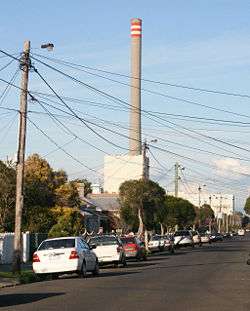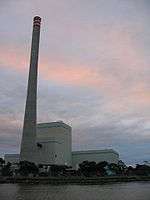Newport Power Station
Coordinates: 37°50′30″S 144°53′42″E / 37.84180°S 144.89489°E

The Newport Power Station was a complex of power stations in the suburb of Newport, Melbourne, Victoria, Australia. Newport A, B, and C coal-fired plants operated at the site between 1919 and the 1980s, while the Newport D 500 MW gas-fired peak load plant has operated since 1981. Old Newport was claimed to be (in terms of the amount of plant) the largest power station in the southern hemisphere in 1953 with 42 boilers and 14 turbo-alternators producing 327 MW.
Newport A, B, and C
Newport 'A' was established as a coal-fired power station by the Victorian Railways in 1918 to supply energy for the electrification of the suburban rail system by the Victorian Railways and businesses that required 25 Hz power. Initially, there were 6 turbo-generators; four were 15 MW capacity and two were 12.5 MW. The speed was 1500 RPM and produced 25 Hz. Steam was supplied by 24 Babcock + Wilcox chain grate boilers at 250 psi. The 2 smaller generators were replaced with a 30 MW Parsons and a 35 MW single cylinder Parsons alternator; numbered A2+A4. Steam was supplied by the 4 "M" boilers, which were pulverized coal-fired at 400 psi. The plant also supplied bulk electricity to the Melbourne City Council Electric Supply Department, the Melbourne Electric Supply Company, and the State Electricity Commission of Victoria. The plant was transferred to the SECV in 1951, when the total capacity was 120 MW.
Newport 'B' station was opened by the SECV in 1923 to supply electricity to Melbourne until the Yallourn power station entered service. Initially there were 2 Parsons 15 MW generators. Speed 3000 RPM and 50 Hz. Later No3 was installed of 30 MW capacity and No8, a Stahl turbine with a capacity of 22 MW. Steam was supplied by 10 B+W chain grate boilers at 250 psi. Total B station capacity was 82 MW.
Newport 'C' station of 120 MW capacity was opened in 1947 by the SECV after wartime delays. There were 4 Parsons 30 MW turbo generators numbered 4,5,6+7. Steam was supplied by 8 "D" type ICAL chain grate boilers, each produced 175000lb/hr at 620 psi and 840 °F. The power station boilers were originally fuelled by imported New South Wales black coal, but were converted to burn brown coal briquettes in the 1950s. Use of the plants declined with the opening of newer power stations in Latrobe Valley, being used for peak loads in later years. These were the last chain grate boilers used in Victoria and were still in service early 1981.[1]
Newport D: Controversy and campaign

Newport 'D' is the current power station on the site. Its construction was immensely controversial, and was the subject of bitter opposition by trade unions and environmentalists throughout the 1970s.
After the initial announcement in 1967 that the State Electricity Commission would construct a large gas-based power station in the working-class suburb, local residents began holding public meetings to discuss the potential harm to the community from pollution. By 1974, the Victorian Trades Hall Council had banned construction on the site. Stand Williams, secretry of the Federated Engine Drivers, declared to the then-Premier of Victoria Rupert Hamer: "The fact is that we're not going to build it at Newport, and that's final." After a temporary retreat, the government attempted to restart the project, but the unions voted to reaffirm the ban. Hamer retaliated by suspending 300 construction projects and announcing a new law that would require secret ballots for construction bans, on pain of deregistration of the union involved. The aggression successfully forced a gradual retreat from the union leadership, under added pressure from the poor economic climate.[2]
A compromise was agreed by the trade union bureaucracy that a panel led by Sir Louis Matheson would investigate the proposed plant. Matheson was considered unsympathetic to the campaign against the plant, as he had risen to national prominence at Monash University as an implacable enemy of student protest during his time as Vice-Chancellor. The panel gave mixed results. Initially it report that even a 500-MW plant at Newport would do unacceptable environmental damage, but its final report endorsed the plant, with reports that some panel members changed their votes at the last minute under political pressure. The campaign continued at the grassroots level, but the trade union leadership refused to seriously enforce construction bans. As a result, protesters invaded Trades Hall Council meetings demanding enforcement of the bans, and protesters clashed with police at the construction site, while campaign meetings continued to draw hundreds of workers and residents. Nonetheless, with the union leadership refusing to enforce a picket or construction ban, construction went ahead and the plant was completed.[3]
In April 1977 the final decision was made by the panel, that the power station at Newport would proceed but with only one 500 MW generator unit, as a result the gas turbine operated Jeeralang Power Station was opened in the Latrobe Valley.[4] The power station is used for meeting peak loads to the electricity grid. Since the privatisation of the Victorian electricity system in the 1990s, the power station has been operated by Ecogen Energy, until purchased by Babcock & Brown Power in 2006,[5] who sold out to co-shareholder Industry Funds Management in 2008.[6]
Newport D was built for the SECV by International Combustion Australia Limited, Rydalmere, NSW.
Carbon Monitoring for Action estimates this power station emits 0.49 million tonnes of greenhouse gases each year.[7] The Australian Government has announced the introduction of a Carbon Pollution Reduction Scheme commencing in 2012 to help combat climate change. It is expected to impact on emissions from power stations. The National Pollutant Inventory provides details of other pollutant emissions, but, as at 23 November 2008, not CO2.
References
- ↑ my own recollections
- ↑ http://www.anu.edu.au/polsci/marx/interventions/uranium.htm
- ↑ http://www.anu.edu.au/polsci/marx/interventions/uranium.htm
- ↑ Aynsley John Kellow (1996). "Victoria: Uncertain Reform". Transforming power: the politics of electricity planning. Cambridge University Press. p. 132. Retrieved 2010-03-07.
- ↑ Rod Myer (13 November 2006). "Big expansion planned for Newport". The Age. theage.com.au. Retrieved 2010-03-07.
- ↑ "Babcock & Brown Power sells Ecogen to pay debt". The Australian. www.theaustralian.com.au. 18 July 2008. Retrieved 2010-03-07.
- ↑ . Carbon Monitoring for Action. Retrieved on 23 November 2008
Further reading
- Jack Johnson, OBE. "The Newport Power Station: A History of Conflict". Light on the Hill: Industrial Relations Reform in Australia. H.R. Nicholls Society. Retrieved 2008-10-05.
- Edwards, Cecil (1969). Brown Power. A jubilee history of the SECV. State Electricity Commission of Victoria.